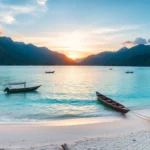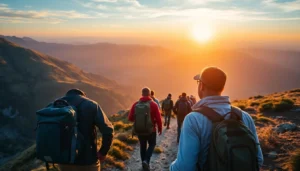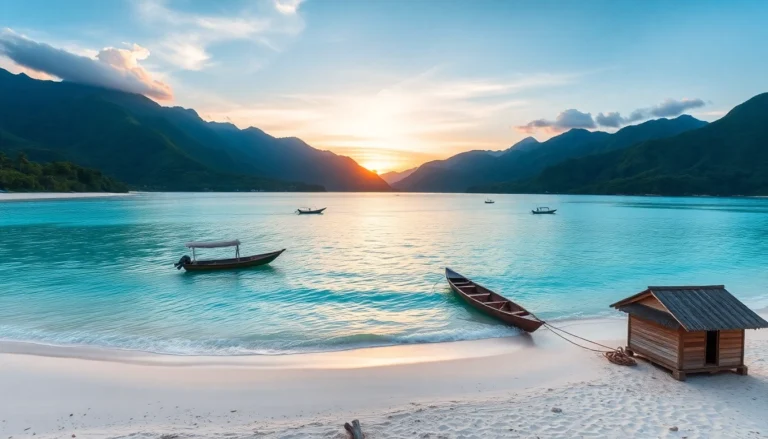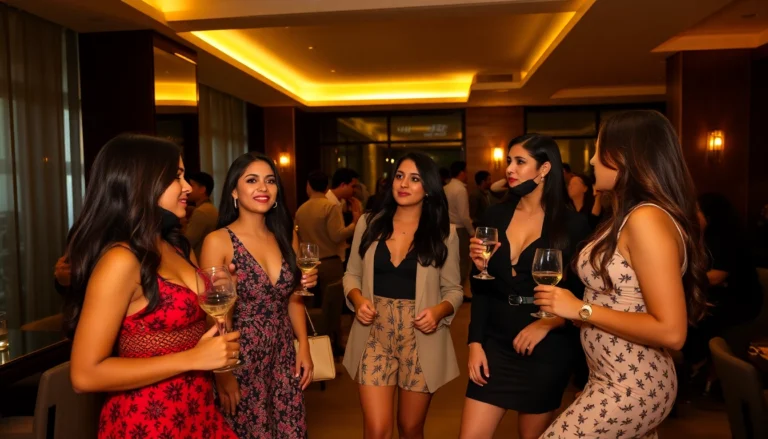Introduction to Lombok: Indonesia’s Diverse and Vibrant Island
Located within the Indonesian archipelago, Lombok stands as a compelling destination renowned for its stunning natural landscapes, rich cultural tapestry, and warm local hospitality. With an estimated population exceeding 4 million residents, Lombok is part of West Nusa Tenggara province and forms one of the Lesser Sunda Islands’ most intriguing islands. Its strategic geographical position, nestled east of Bali and separated by the Lombok Strait, offers travelers an accessible yet distinctly unique Indonesian island experience. Whether you are an avid adventure seeker, cultural enthusiast, or a leisure traveler seeking pristine beaches, Lombok balances diverse attractions that appeal to a broad spectrum of interests. This comprehensive guide explores what makes Lombok a premier travel destination, delving into its geographical importance, cultural heritage, key attractions, and practical travel advice that will help you plan an unforgettable journey.
Geographical overview and significance of Lombok
Geographically, Lombok forms a crucial part of Indonesia’s Lesser Sunda Islands, sharing borders with neighboring islands such as Sumbawa and Bali. The island spans approximately 4,725 square kilometers, characterized by rugged mountain ranges, lush forests, and extensive coastlines. The Lombok Strait, a pivotal waterway, separates Lombok from Bali, serving not only as a natural barrier but also as a critical maritime corridor for trade and transportation. This strait also hosts the powerful Indian Ocean currents that influence Lombok’s climate and marine biodiversity.
The island is most famously dominated by Gunung Rinjani, Indonesia’s second-highest volcano, which stands at 3,726 meters above sea level. Rinjani is not only a significant geographical feature but also a cultural icon, symbolizing the spiritual connection of the local Sasak people. The volcano’s active status contributes to Lombok’s fertile volcanic soil, making it an important agricultural area for rice, spices, and coffee cultivation.
From a geopolitical standpoint, Lombok holds strategic importance due to its proximity to other significant regions in Indonesia. Its natural harbor and transparent waters facilitate trade routes, while its diverse ecosystems support sustainable tourism and fishing industries. In recent years, infrastructural developments such as new airports, improved roads, and tourism facilities have enhanced Lombok’s connectivity, positioning it as an essential node in Indonesia’s tourism network.
Key highlights that make Lombok unique
Lombok’s allure lies in its harmonious blend of natural beauty, vibrant culture, and adventure opportunities. Its sandy beaches, turquoise waters, and rich marine life attract divers and snorkelers. The island’s inland terrain offers challenging hikes, especially around Gunung Rinjani, which attracts trekkers from all over the world. Additionally, Lombok’s cultural authenticity sets it apart, as preserved traditional arts, crafts, and festivals offer travelers immersive experiences.
Unique features that define Lombok include:
- Natural Diversity: From pristine beaches like Tanjung Aan and Selong Belanak to waterfalls such as Sendang Gile, the island presents varied ecosystems.
- Mount Rinjani: An active volcano with diverse trekking routes, hot springs, and a crater lake that provides a surreal landscape.
- Marine Bounty: The Gili Islands – Gili Trawangan, Gili Air, and Gili Meno – are world-renowned for their coral reefs, vibrant nightlife, and relaxed pace.
- Cultural Heritage: The Sasak culture, traditional weaving, and local crafts offer a glimpse into Indonesia’s indigenous heritage.
What truly makes Lombok stand out is its potential for eco-tourism and community-based tourism initiatives, which focus on sustainable development while preserving local traditions and environments.
Historical and cultural context of Lombok’s development
The history of Lombok is deeply intertwined with the broader narrative of Indonesian culture and influences from neighboring regions. Originally inhabited by the Austronesian peoples, Lombok’s early history was marked by the rise of indigenous kingdoms and trade networks spanning Southeast Asia and beyond. The island saw the influence of Indian and Chinese traders as early as the 5th century, leaving behind a legacy seen in traditional arts and religious practices.
The arrival of Islam in the 15th century significantly shaped Lombok’s cultural identity, with the majority of the Sasak population practicing Islamic faith today. Colonial-era interactions, particularly during the Dutch period, introduced new elements, including infrastructure and education systems, which laid foundation stones for modern development.
In contemporary times, Lombok has transformed from a primarily agricultural society into a growing tourism hub. Its development has always balanced modernization with the preservation of traditions—fire ceremonies, weaving arts, and local festivals such as Bau Nyale (the sea worm festival) retain cultural importance. The island’s political landscape has been relatively stable, fostering an environment conducive to growth and cultural pride.
This historical and cultural grounding enriches every experience on the island, offering travelers not only stunning sights but also a deep connection to the indigenous way of life.
Top Attractions and Must-Visit Destinations in Lombok
Main tourist spots: beaches, waterfalls, and mountains
Lombok’s main attractions encompass a diverse array of natural and man-made sites. The beaches of Kuta, Tanjung Aan, and Senggigi are perfect for sunbathing, surfing, and water sports. The waterfalls of Sendang Gile and Tiu Kelep, nestled in lush mountain forests near Mount Rinjani, offer refreshing escapes. The majestic Gunung Rinjani itself is a magnet for trekkers, with trails ranging from moderate hikes to multi-day expeditions that ascend to its crater lake, Segara Anak.
Gunung Rinjani: Indonesia’s second-highest volcano
Rinjani stands as an iconic symbol of Lombok’s adventurous appeal. The volcano is not only a geological marvel but also a spiritual landmark for the local Sasak and Hindu communities. Trekkers can choose routes from beginner to advanced levels, with popular starting points in Senaru and Sembalun Lawang. The journey typically takes 2-4 days, offering panoramic views, hot springs, and a serene crater lake submerged within volcanic activity’s remnants.
Hidden gems and lesser-known sites for adventurous travelers
Beyond the well-trodden paths, Lombok presents numerous hidden treasures. The desert-like Segara Reef for snorkeling, the pristine Gili Nanggu island for relaxation, and the ancient sovereignty temples scattered in remote villages are just some examples. Local guides can assist explorers in discovering secluded beaches, traditional villages like Sade and Sukarara, and hidden waterfalls tucked into the island’s interior.
These lesser-known sites offer authentic experiences away from crowds, perfect for travelers seeking adventure and cultural immersion.
Experiencing Lombok’s Rich Culture and Traditions
Local customs, festivals, and cultural events
Lombok’s cultural landscape is vibrant and deeply rooted in indigenous traditions. The Sasak people celebrate numerous festivals, with Bau Nyale being the most renowned—a historic event where locals gather to catch sea worms, believed to symbolize a princess’s legend, creating a lively and colorful spectacle. Another significant festival is the Islamic Eid al-Fitr, celebrated with prayers, feasts, and traditional dances.
These festivals are occasions for community gathering, showcasing traditional attire, music, and dance. Attending such events provides invaluable insight into the local psyche and cultural resilience.
Traditional arts, crafts, and culinary delights
Lombok’s handicrafts feature intricate weaving, pottery, and wood carving, often using locally sourced materials. The ikat weaving from Sade, a heritage craft, exemplifies the island’s artistic mastery. Culinary traditions feature dishes like Plecing Kangkung (spicy water spinach), Ayam Taliwang (grilled spicy chicken), and fresh seafood caught daily along the coast. Festivals often include traditional performances, with gamelan music and dance, offering tourists vibrant cultural displays.
Visiting desa wisata: authentic village experiences
Tourists seeking immersion can visit desa wisata (village tourism sites) where community-led programs promote cultural exchange. Village visits include traditional house tours, cooking classes, and participation in local ceremonies. These experiences foster understanding and support sustainable tourism practices, ensuring that local communities benefit substantially from tourism activities.
Practical Travel Tips for Visiting Lombok
Best time to visit for optimal weather and events
The ideal time to explore Lombok is during the dry season, typically from May to September, when rainfall is minimal, and outdoor activities are most enjoyable. Avoid the rainy season between November and March, which can hamper trekking and beach activities. Special events like Bau Nyale are celebrated in February and March, coinciding with the lunar calendar, so planning around these dates enhances cultural experiences.
Transportation options and getting around the island
Transportation options include rental scooters, private drivers, and local buses. For flexibility, renting a scooter is popular among backpackers, but travelers should exercise caution due to varied road conditions. Car rentals with drivers offer comfort and safety for longer excursions. Domestic flights connect Lombok’s airport to Jakarta, Bali, and other destinations, while ferries from Bali provide scenic arrivals for cruise travelers.
Accommodation, safety tips, and local etiquette
Lombok provides a wide range of accommodations, from budget guesthouses in Kuta to luxury resorts along Senggigi. When visiting local villages, dress modestly, especially during religious festivals or visits to temples. Travelers should respect local customs, avoid sensitive topics, and seek permission before photographing people. Health precautions include ensuring access to clean water and staying updated on recommended vaccinations. Overall, being courteous and environmentally conscious fosters positive interactions with locals and safeguards the island’s pristine environment.
Planning Your Perfect Lombok Vacation
Customized itineraries for nature lovers, adventure seekers, and cultural explorers
Designing a Lombok itinerary tailored to your interests involves balancing adventure, relaxation, and cultural immersion. For nature enthusiasts, a typical plan may include sunrise hikes on Rinjani, snorkeling at Gili Air, and visits to waterfalls like Tiu Kelep. Adventure seekers can include day trips for surfing, mountain biking, and diving. Cultural explorers should allocate time exploring traditional Sasak villages, participating in local ceremonies, and sampling authentic cuisine.
Top travel agencies and guided tour options
Several local and international tour operators specialize in Lombok experiences, offering packages ranging from private customized tours to group adventures. Coordinated treks, diving excursions, and cultural tours are available with experienced guides who understand the island’s unique environment and heritage. Engaging a reputable guide enhances safety, provides local insights, and ensures authentic interactions.
Enhancing your trip with local festivals and culinary tours
Timing your visit with major festivals amplifies cultural exposure. Participating in Bau Nyale, exploring traditional markets, and enjoying culinary tours featuring Lombok’s signature dishes enrich the overall experience. Cooking classes, led by local chefs, allow visitors to learn endemic recipes and bring home a taste of Lombok’s culinary heritage.

















